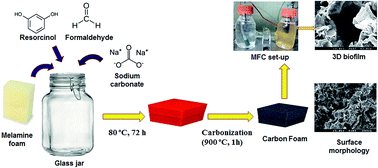Three-dimensional, highly porous N-doped carbon foam as microorganism propitious, efficient anode for high performance microbial fuel cell†
Abstract
Three-dimensional (3D) N-doped open-porous carbon foam was fabricated using the simple procedure of calcining a melamine sponge. The properties of the fabricated carbon foam and its performance in microbial fuel cells (MFCs) using Shewanella oneidensis MR-1 (S. oneidensis) were compared with those of commercial graphite felt. The MFC with the carbon foam anode produced approximately 2 times higher power density than the commercial graphite felt. The superior performance of the as-prepared carbon foam in MFC was attributed to the higher surface area (687.19 m2 g−1) and open-porous scaffold structure. Moreover, the appearance of the hydrophilic functional groups such as C![[double bond, length as m-dash]](https://www.rsc.org/images/entities/char_e001.gif) N–C, N–C
N–C, N–C![[double bond, length as m-dash]](https://www.rsc.org/images/entities/char_e001.gif) O on the surface of the as-prepared carbon foam facilitated extracellular electron transfer, resulting in a decrease in charge transfer resistance and an increase in biocompatibility. Owing to the excellent biocompatibility, a large amount of microbial biomass colonized both the surface and inside the carbon foam, which helped enhance the performance of the MFC.
O on the surface of the as-prepared carbon foam facilitated extracellular electron transfer, resulting in a decrease in charge transfer resistance and an increase in biocompatibility. Owing to the excellent biocompatibility, a large amount of microbial biomass colonized both the surface and inside the carbon foam, which helped enhance the performance of the MFC.


 Please wait while we load your content...
Please wait while we load your content...